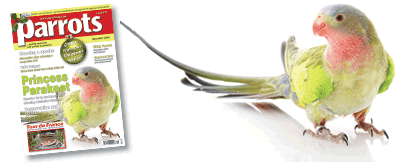
Buy your copy now!
Save money if you subscribe - 12 issues for the price of 11
In this issue...
- A visit to a local parrot adoption facility - read more
- The link between coffee and parrot conservation - read more
- Touring Europe with two Amazons - read more
- Choosing the right companion parrot - read more
- The Princess of Wales parakeet - read more
- Respecting the bite - read more
- News, Bird Alert, Readers Story, FREE classified advertising and special Christmas offers
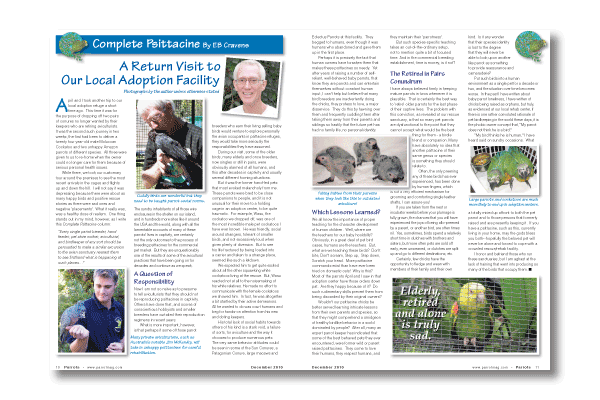
A Return Visit to Our Local Adoption Facility
April and I took another trip to our local adoption refuge a short time ago. This time it was for the purpose of dropping off two pairs of conures no longer wanted by their keepers who are retiring aviculturists. It was the second such journey in two weeks, the first had been to deliver a twenty four year-old male Moluccan Cockatoo and two unhappy Amazon parrots of different species. All three were given to us to re-home when the owner could no longer care for them because of serious personal health issues.
While there, we took our customary tour around the premises to see the most recent arrivals in the cages and flights up and down the hill. I will not say it was depressing because there were about as many happy birds and positive rescue stories as there were sad ones and negative ‘placements’. What it really was, was a healthy dose of realism. One thing stands out in my mind, however, as I write this Complete Psittacine column:
“Every single parrot breeder, hand feeder, pet store worker, aviculturist, and birdkeeper of any sort should be persuaded to make a similar excursion to the avian sanctuary nearest them to see firsthand what is happening at such places…”
Read more in the magazine…
Buy a copy now!
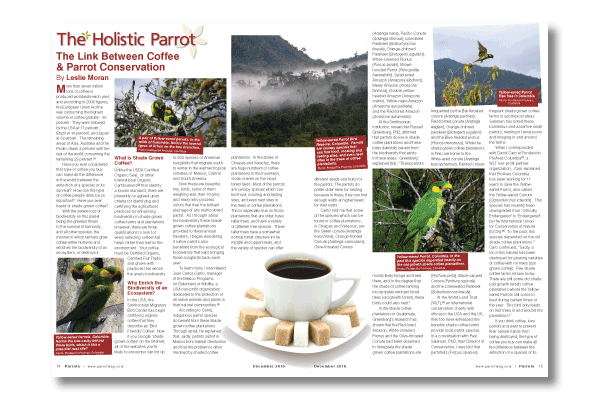
The Link Between Coffee & Parrot Conservation
More than seven million tons of coffee is produced worldwide each year, and according to 2006 figures, the European Union led the way consuming the highest volume of coffee globally - 36 percent. They were followed by the USA at 17 percent, Brazil at 14 percent, and Japan at 6 percent. The remaining areas of Asia, Australia and the Pacific drank 4 percent with the rest of the world consuming the remaining 23 percent.
Have you ever considered that type of coffee you buy can make all the difference in the world between the extinction of a species or its survival? How can the type of coffee people drink be so important? Have you ever heard of shade grown coffee?
With the severe loss of biodiversity on this planet being the greatest threat to the survival of humanity, and all other species, the manner in which farmers grow coffee either nurtures and enriches the biodiversity of an ecosystem, or destroys it.
Read more in the magazine…
Buy a copy now!
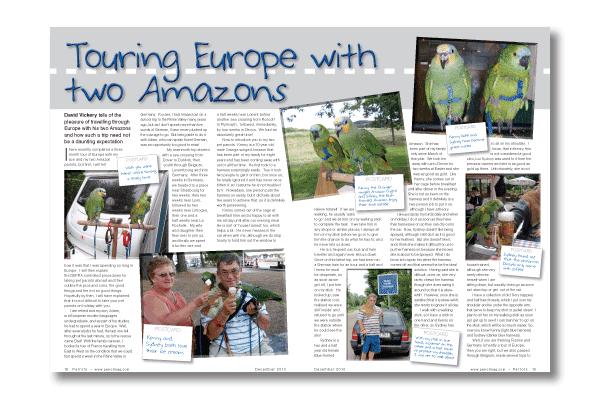
Touring Europe with two Amazons
David Vickery tells of the pleasure of travelling through Europe with his two Amazons and how such a trip need not be a daunting expectation.
I have recently completed a three month tour of Europe with my son and my two Amazon parrots, but first, I will tell how it was that I was spending so long in Europe. I will then explain the DEFRA controlled procedures for taking pet parrots abroad and then outline the pros and cons, the good things and the not so good things. Hopefully by then, I will have explained that it is not difficult to take your pet parrots on holiday with you.
I am retired and my son, Adam, is a European modern languages undergraduate, and as part of his studies, he had to spend a year in Europe. Well, after several jobs he had, the last one fell through at the last minute, so to the rescue came Dad! With the family caravan, I booked a tour of France travelling from East to West on the condition that we could first spend a week in the Rhine Valley in Germany. You see, I had missed out on a school trip to the Rhine Valley many years ago, but as I don’t speak more than five words of German, I have never plucked up the courage to go. But being able to do it with Adam, who can speak fluent German, was an opportunity too good to miss!
Read more in the magazine…
Buy a copy now!
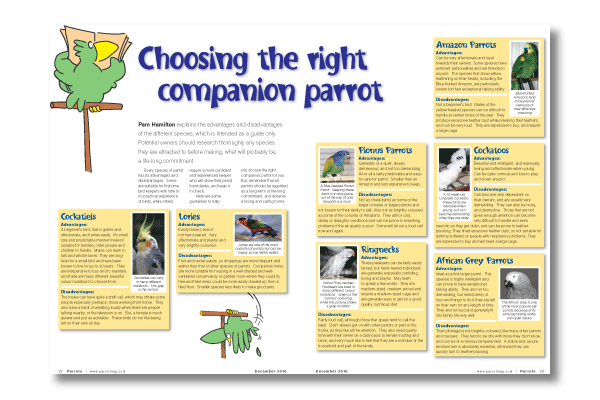
Choosing the right companion parrot
Pam Hamilton explains the advantages and disadvantages of the different species, which is intended as a guide only. Potential owners should research thoroughly any species they are attracted to before making, what will probably be, a life-long commitment.
Every species of parrot has its advantages and disadvantages. Some are suitable for first-time bird keepers with little or no practical experience of birds, while others require a more confident and experienced keeper who will show their parrot boundaries, and keep it in check.
Here are some guidelines to help you choose the right companion parrot for you. But, remember that all parrots should be regarded as a long-term or life-long commitment, and deserve a loving and caring home.
Read more in the magazine…
Buy a copy now!
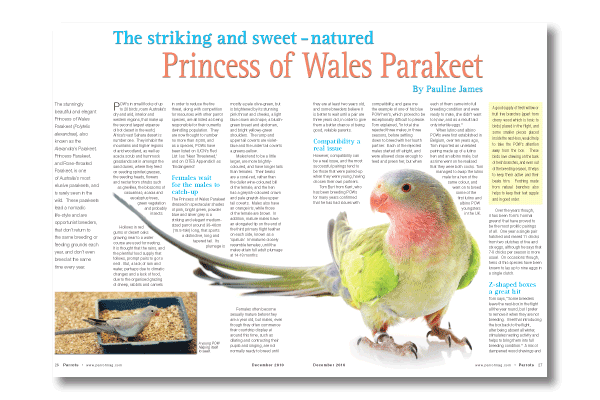
The striking and sweet-natured Princess of Wales Parakeet
The stunningly beautiful and elegant Princess of Wales Parakeet (Polytelis alexandrae), also known as the Alexandra’s Parakeet, Princess Parakeet, and Rose-throated Parakeet, is one of Australia’s most elusive parakeets, and is rarely seen in the wild. These parakeets lead a nomadic life-style and are opportunist breeders, that don’t return to the same breeding or feeding grounds each year, and don’t even breed at the same time every year.
POW’s in small flocks of up to 20 birds, roam Australia’s dry and arid, interior and western regions, that make up the second largest expanse of hot desert in the world, Africa’s vast Sahara desert is number one. They inhabit the mountains and higher regions of arid woodland, as well as acacia scrub and hummock grasslands set in amongst the sand dunes, where they feed on seeding spinifex grasses, the seeding heads, flowers and nectar from shrubs such as grevillea, the blossoms of casuarinas, acacia and eucalyptus trees, green vegetation and probably insects.
Hollows in red gums or desert oaks growing near to a water course are used for nesting. It is thought that the rains, and the plentiful food supply that follows, prompt pairs to go to nest. But, a lack of rain and water, perhaps due to climatic changes and a lack of food, due to the organised grazing of sheep, rabbits and camels in order to reduce the fire threat, along with competition for resources with other parrot species, are all listed as being responsible for their currently dwindling population. They are now thought to number no more than 5,000, and as a species, POWs have been listed on IUCN’s Red List I as ‘Near Threatened,’ and on CITES Appendix II as ‘Endangered.’
Read more in the magazine…
Buy a copy now!






